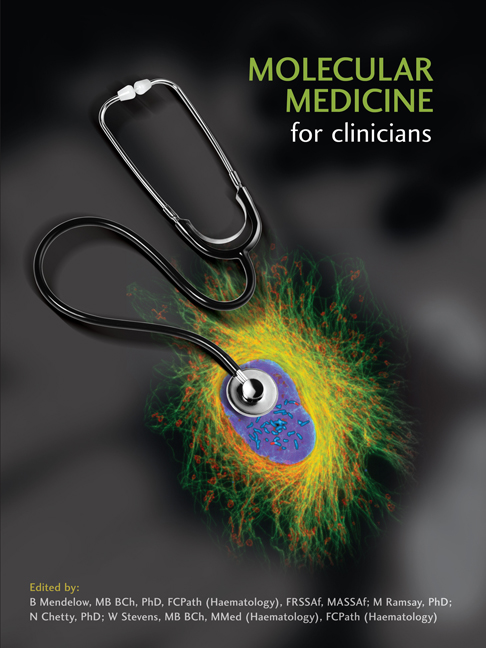Book contents
- Frontmatter
- Contents
- Foreword
- Acknowledgements
- Chapter 1 Introduction
- Keynote Essay 1: Defining Who We Are: DNA in Forensics, Genealogy and Human Origins
- Section 1 Principles Of Cellular And Molecular Biology
- SECTION 2 MOLECULAR PATHOLOGY
- SECTION 3 MOLECULAR THERAPEUTICS
- Chapter 32 Targets for Molecular Therapy: The Biology of Haemostasis
- Chapter 33 Cellular Targets of Antiplatelet Agents
- Chapter 34 Rational Drug Design
- Chapter 35 Chronic Myeloid Leukaemia
- Chapter 36 Gene Therapy
- Chapter 37 Diabetes Mellitus
- Chapter 38 Pharmacogenetics
- Chapter 39 Basic Molecular Biology of Blood Groups
- Keynote Essay 6: Molecular Research Case Study: Developing Novel RNA Interference-based Therapy
- SECTION 4 RESEARCH AND THE CONTINUING EVOLUTION OF MOLECULAR MEDICINE
- Glossary
- Contributors’ Biographies
- Source Material And Recommended Reading
- Permissions And Credits
- Index
Chapter 33 - Cellular Targets of Antiplatelet Agents
from SECTION 3 - MOLECULAR THERAPEUTICS
Published online by Cambridge University Press: 04 June 2019
- Frontmatter
- Contents
- Foreword
- Acknowledgements
- Chapter 1 Introduction
- Keynote Essay 1: Defining Who We Are: DNA in Forensics, Genealogy and Human Origins
- Section 1 Principles Of Cellular And Molecular Biology
- SECTION 2 MOLECULAR PATHOLOGY
- SECTION 3 MOLECULAR THERAPEUTICS
- Chapter 32 Targets for Molecular Therapy: The Biology of Haemostasis
- Chapter 33 Cellular Targets of Antiplatelet Agents
- Chapter 34 Rational Drug Design
- Chapter 35 Chronic Myeloid Leukaemia
- Chapter 36 Gene Therapy
- Chapter 37 Diabetes Mellitus
- Chapter 38 Pharmacogenetics
- Chapter 39 Basic Molecular Biology of Blood Groups
- Keynote Essay 6: Molecular Research Case Study: Developing Novel RNA Interference-based Therapy
- SECTION 4 RESEARCH AND THE CONTINUING EVOLUTION OF MOLECULAR MEDICINE
- Glossary
- Contributors’ Biographies
- Source Material And Recommended Reading
- Permissions And Credits
- Index
Summary
INTRODUCTION
Platelets are anuclear and circulate in the bloodstream as discoid, smooth-surfaced cells about 1–3 μm in diameter. They have a circumferential band of microtubules and two membrane systems, the endoplasmic reticulum or dense tubular system and the plasma membrane-derived surface-connected canalicular system. They also contain alpha granules, dense granules, lysosomes and peroxisomes. The alpha granules contain various poly - peptides including fibrinogen, fibronectin and platelet-derived growth factor (PDGF). Dense granules contain adenosine triphosphate (ATP), adenosine diphosphate (ADP) and calcium ions. Platelets play a major role in thrombosis (formation of a blood clot) and haemostasis (arrest of bleeding) after injury.
The platelet membrane has receptors that are poised for immediate interaction with specific adhesive proteins when an area of vascular damage is encountered. These receptors mediate adhesion to subendo thelium, followed by platelet activation, aggregation with other platelets and formation of a firm platelet plug at the site of the vascular leak. When platelets moving along the vessel wall encounter an area of denuded endothelium, they adhere to the subendo thelial matrix, undergo a change in shape to a sphere with multiple pseudopods, and spread to increase their area of surface contact. Agonists in the microenvironment interact with specific receptors on the platelet surface. The agonist-receptor binding transmits signals from outside the cell to the interior, generating second messengers that induce protein phosphorylation and ion channels. As a result, there is activation of the contractile proteins, secretion of granule contents, an increase in adhesion, recruitment of additional platelets by aggregation, thrombus formation and haemostasis.
RECEPTOR-MEDIATED ADHESION
The platelet membrane contains a number of glycoproteins (GPs) that are receptors for adhesive proteins present both in the vessel wall and in plasma. These GPs have been named from GPI to GPIX. The platelet adhesion receptors include GPIa/IIa for colla gen, GPIc/IIa for fibronectin, GPIb for von Willebrand factor (vWF), GPIIb/IIIa fibrin ogen, vWF, fibronectin and vitronectin. The inter action of platelet GPIb with vWF induces intracellular signalling, resulting in a conformational change and activation of the integrin GPIIb/IIIa. vWF then binds irreversibly to the activated GPIIb/IIIa, producing firm adhesion of the platelet to the vessel wall.
- Type
- Chapter
- Information
- Molecular Medicine for Clinicians , pp. 391 - 395Publisher: Wits University PressPrint publication year: 2008



